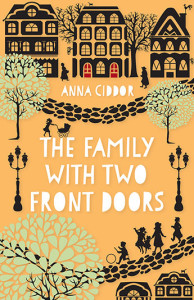The place is Lublin in Poland, the time the 1920s. The large, joyous Rabinovitch family, based on the family of the author’s grandmother, have to spread out across two first floor apartments because there are nine children and Papa is a rabbi, who needs an office where he can advise members of the community who come to him for help: hence the two front doors.
The entire novel is centred around preparations for the wedding of fifteen-year-old Adina, the eldest daughter.  To be honest, not a lot happens in The Family With Two Front Doors (Allen and Unwin). The family prepares for the September wedding and meanwhile, the girls cook and clean and look after younger siblings, prepare delicious meals for the Sabbath and go on the odd picnic.
To be honest, not a lot happens in The Family With Two Front Doors (Allen and Unwin). The family prepares for the September wedding and meanwhile, the girls cook and clean and look after younger siblings, prepare delicious meals for the Sabbath and go on the odd picnic.
But then, not a lot happens in Little Women either; Meg, Jo, Beth and Amy work, play, write, produce little plays for their own amusement, go on picnics, take the advice of their wise Marmee and wait for their minister father to return from the American Civil War. All about daily life! Somehow, it managed to become a classic and be filmed several times anyway. And Anna Ciddor’s web site suggests that she had in mind Laura Ingalls Wilder’s Little House series.
Somehow, every one of the nine children has a personality, though the story is told from the viewpoints of only two, Nomi and her younger brother Yakov. There is a charming drawing of the family at the front of the book, along with some internal illustrations in each chapter, drawn by the author who, it seems, is a bit like Melbourne children’s writer/illustrator Gabrielle Wang in this respect!
The organization of the Rabinovitch women is phenomenal. Imagine having to prepare the equivalent of a dinner party every single week (Sabbath meal), not only for the family but for any random strangers Dad might bring home from the synagogue service on Friday night. These people might have come from out of town and couldn’t travel on Sabbath, so a family would offer them dinner, next day’s lunch and a place to sleep meanwhile. So, a weekly dinner party (don’t forget the dishes) and, on the holy days, a feast for the extended family. And more dishes. And a house to clean and you absolutely have to make sure that there isn’t anything un-kosher allowed into the house. Two lots of dishes to wash in two separate sinks and so on.
Organization is the keyword here. Even today, a religious household needs it and I remember a member of my librarianship class, a religious Jewish woman who ran her Orthodox household, cooked, cleaned, did all the observances and still managed to come top of the year in what has to be the toughest course of study I have ever done. She didn’t see what the fuss was about; it was just what she did. It may go some way, though, to explaining why she was able to get all her studies done and end up with first place.
Some of my mother’s memories are very close to the stories in this book. Like the heroine, Nomi, she had a local bakery where she was sent to collect her mother’s challah and chulent (a delicious slow-cooked casserole of beans, vegetables and meat, cooked overnight so that religious families can have a hot lunch without breaking the rules about lighting a fire on the Sabbath. And there were random visitors every week in the Altbaum home, as in the Rabinowitz household.
Did I mention the food? I really don’t care for Eastern European food in general, but it’s impossible to read this without a watering mouth. And, in my case, a reason for a watering mouth, since I’ve tasted quite a lot of that food. I can imagine some restaurant doing a Babette’s Feast or Big Night event based on this novel.
The only sad thing about reading it was thinking of the fact that it’s set only about 15 years before the Holocaust would sweep away the world of this delightful family forever — and most of the family itself — as it did for my parents’ families. Sure enough, there was an author’s note at the end, in which we learned that only three of the children survived, her grandmother and two of her sisters.
Still, all we can say here is “They tried to kill us, we survived, let’s eat!”
Let’s raise a hat to Anna Ciddor’s wonderful family from Lublin. ◊
Sue Bursztynski lives in Australia, where she works as a teacher-librarian. She has written several books for children and young adults, including Crime Time: Australians Behaving Badly and, most recently, the YA novel Wolfborn. Her blog, The Great Raven, can be found at http://suebursztynski.blogspot.com.

Beautiful review, Sue. I can’t wait to read the book.
Make sure you have something to eat while you read!